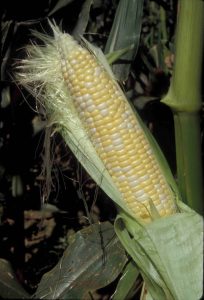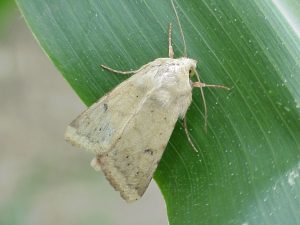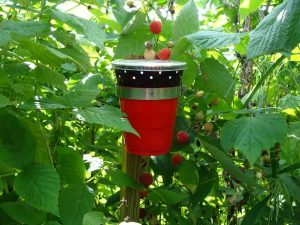Sweet Corn IPM Newsletter No. 6- August 7, 2020
Sweet Corn IPM Newsletter No. 6 – August 7, 2020
Click on photos to enlarge.
CORN EARWORM, FALL ARMYWORM NUMBERS HIGHER
Moth Counts Rise Significantly in Most Fields Following Tropical Storm
SITUATION
Corn harvest is underway in earnest around most of the state. Growing conditions continue to be good. The recent tropical storm packed enough wind to lodge corn in a few fields, but the most important impact may be a wave of corn earworm and fall army worm that rode up into Maine on the front. Moth counts are up at most sites this week, and larval feeding damage to young corn is increasing.
European corn borer:

Larval feeding injury was not over the 15% control threshold for pre-tassel corn at any location scouted this week. Moth counts remained low in most fields, except sites in Sabattus and Wayne, where counts were higher (suggesting a possible second generation emerging) and exceeded the threshold for silking corn in Sabattus and Wayne.
Corn earworm:

Moth captures climbed significantly at nearly all locations this week, likely a result of the tropical storm that came up from the south. This increases the threat to all fresh silking corn. A four-day interval for silking corn was recommended in: Auburn, Biddeford, Bowdoinham, Corinth, Farmington, Lewiston, Levant, New Gloucester, Monmouth, Poland Spring, Sabattus, Wayne, one Cape Elizabeth site, one Dayton site and one Wells site. A five-day spray interval was recommended in: Charleston, and one Wells site. A six-day spray interval was recommended for silking fields in Oxford, Palmyra, one Cape Elizabeth site, and one Dayton site.
Fall armyworm (FAW):

Moth captures were much higher at most locations this week, increasing the threat to both silking and pre-tassel corn. Moths exceeded the three-per-week threshold for silking corn in: Biddeford, Bowdoinham, Cape Elizabeth, Dayton, Farmington, Levant, Monmouth, New Gloucester, Oxford, Poland Spring, Sabattus, Wayne and one Wells site. However, all sites are presently under a spray interval for corn earworm, so no additional spray for FAW should be needed. Fall armyworm larval feeding damage on younger corn exceeded the 15% threshold in Biddeford, Bowdoinham, Cape Elizabeth, and one Dayton site. High moth counts suggest larval feeding pressure on younger corn may increase in the coming days.

Western Bean Cutworm:
Moths are being found at more locations and in higher numbers this week, including; Auburn (56), Biddeford (30), Bowdoinham (4), Cape Elizabeth (108), Dayton (101), Lewiston (13), Farmington (25), Monmouth (4), New Gloucester (40), Oxford (14), Poland Spring (55), Sabattus (18), Wayne (93) and Wells (35). However, All locations are now on a spray interval for corn earworm, which should also protect silking corn from western bean cutworm.

Squash vine borer moths were caught in pheromone traps in Biddeford (1), Oxford (1) and Wells (8) this week. Only the Wells site was over the threshold of five moths per week to protect squash and pumpkins.

Spotted wing drosophila:
Fly trap counts continue to increase this week, raising the threat level to any ripening raspberries, blackberries and blueberries. For more information visit our website:
Sincerely,
David T. Handley
Vegetable and Small Fruit Specialist
Highmoor Farm Pest Mgmt. Unit
P.O. Box 179 17 Godfrey Drive
52 U.S. Route 202 Orono, ME 04473
Monmouth, ME 04259 1.800.287.0279
207.933.2100
| Location | CEW
Moths |
ECB
Moths |
FAW
Moths |
%Feeding
Damage |
Recommendations / Comments |
|---|---|---|---|---|---|
| Auburn | 31 | 1 | 31 | 4% | 4-day spray interval for all silking corn |
| Biddeford | 19 | 0 | 88 | 32% | 4-day spray interval for all silking corn |
| Bowdoinham | 39 | 1 | 24 | 21% | 4-day spray interval for all silking corn |
| Cape Elizabeth I | 2 | 0 | 33 | 20% | 6-day spray interval for all silking corn |
| Cape Elizabeth II | 43 | 0 | 36 | 27% | 4-day spray interval for all silking corn |
| Charleston | 5 | 0 | 0 | 0% | 5-day spray interval for all silking corn |
| Corinth | 19 | 0 | 0 | 0% | 4-day spray interval for all silking corn |
| Dayton I | 8 | 3 | 54 | 15% | 4-day spray interval for all silking corn |
| Dayton II | 3 | 0 | 6 | 0% | 6-day spray interval for all silking corn |
| Farmington | 15 | 3 | 6 | 4-day spray interval for all silking corn | |
| Lewiston | 36 | 4 | 0 | 4-day spray interval for all silking corn | |
| Levant | 18 | 0 | 7 | 4-day spray interval for all silking corn | |
| Monmouth | 23 | 1 | 4 | 4-day spray interval for all silking corn | |
| New Gloucester | 18 | 0 | 69 | 7% | 4-day spray interval for all silking corn |
| Oxford | 3 | 0 | 11 | 3% | 6-day spray interval for all silking corn |
| Palmyra | 2 | 0 | 1 | 1% | 6-day spray interval for all silking corn |
| Poland Spring | 11 | 4 | 6 | 0% | 4-day spray interval for all silking corn |
| Sabattus | 10 | 23 | 7 | 0% | 4-day spray interval for all silking corn |
| Wayne | 58 | 14 | 38 | 4% | 4-day spray interval for all silking corn |
| Wells I | 7 | 0 | 1 | 0% | 5-day spray interval for all silking corn |
| Wells II | 16 | 0 | 14 | 0% | 4-day spray interval for silking corn |
CEW: Corn earworm (Only fresh silking corn should be sprayed for this insect.)
ECB: European corn borer
FAW: Fall armyworm
| Moths caught per week | Moths caught per night | Spray interval |
|---|---|---|
| 0.0 to 1.4 | 0.0 to 0.2 | No spray |
| 1.5 to 3.5 | 0.3 to 0.5 | Spray every 6 days |
| 3.6 to 7.0 | 0.6 to 1.0 | Spray every 5 days |
| 7.1 to 91 | 1.1 to 13.0 | Spray every 4 days |
| More than 91 | More than 13 | Spray every 3 days |
Thresholds apply only to corn with exposed fresh silk. Lengthen spray intervals by one day if the maximum daily temperature is less than 80°F.
European Corn Borer Thresholds
Whorl stage: 30% or more of plants scouted show injury.
Pre-tassel-silk: 15% or more of plants scouted show injury.
Silk: 5 or more moths caught in pheromone traps in one week.
IPM Web Pages:
Where brand names or company names are used, it is for the reader’s information. No endorsement is implied nor is any discrimination intended against other products with similar ingredients. Always consult product labels for rates, application instructions and safety precautions. Users of these products assume all associated risks.
The University of Maine is an equal opportunity/affirmative action institution.
